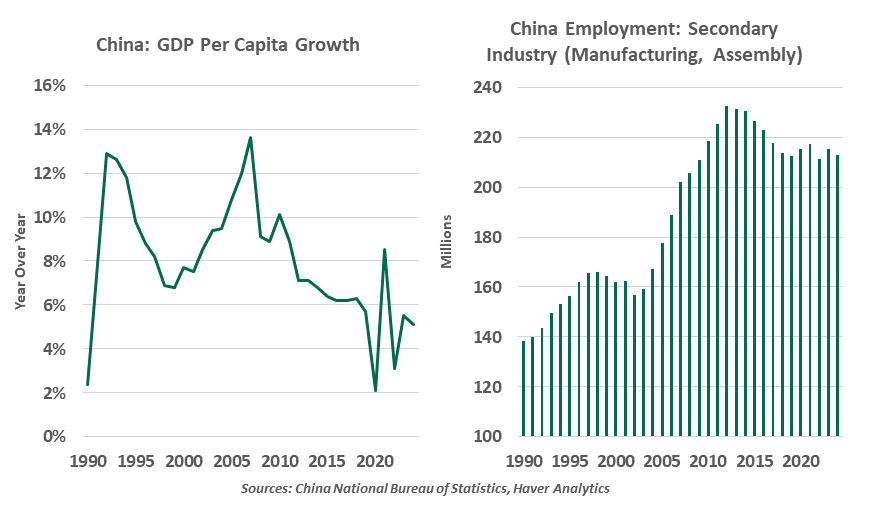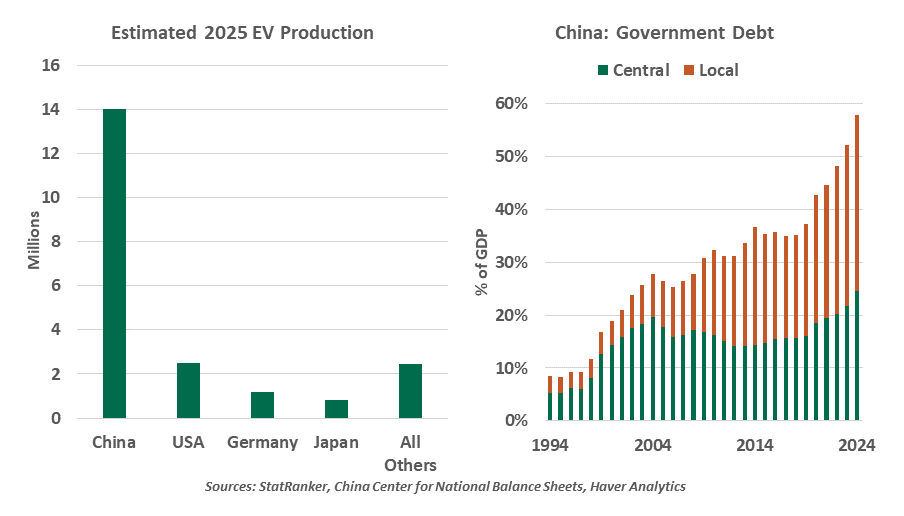- Who We Serve
- What We Do
- About Us
- Insights & Research
- Who We Serve
- What We Do
- About Us
- Insights & Research
Looking Back On Made In China 2025
An ambitious policy yielded great gains and high debts.
By Ryan Boyle
“Manufacturing is the mainstay of the national economy, the basis on which the nation is established, an instrument of rejuvenation, and the foundation of a world power….Without a strong manufacturing industry, there will be no country and no nation.”
The quote above could have been part of the Republican platform in 2024. But it was actually published ten years ago as the preamble to the Made in China 2025 (MIC25) policy. With 2025 now upon us, a retrospective on MIC25 offers a case study of how industrial policy can work. But the review also reveals that the effort comes at a cost.
MIC25 was published as China sought to transition from simply being the world’s leading producer to leading the global economy. Though 2015, the nation had seen tremendous growth and a rising standard of living by taking manufacturing from the rest of the world. The limits of that approach were in sight, and gains were leveling off; there was only so much more that could move to China. With MIC25, the nation sought to increase the nation’s capabilities to innovate and dominate new arenas.

MIC25 targeted ten sectors, ranging widely from farming equipment to bio-medicine to information technology to aerospace. All of these sectors shared a goal of improving innovation, fostering Chinese brands, and enforcing greener manufacturing. Specific targets were outlined within each sector, like increasing the domestic content of core materials to 70% by 2025.
The objectives of MIC25 stand out for their breadth. The entire manufacturing process was in scope, not just a push into leading-edge technologies. Both traditional and advanced sectors received renewed investment. The South China Morning Post estimated that 86% of the plan’s goals were achieved; in a broad review, the Rhodium Group concluded China made “clear and undeniable progress” over the past decade.
China’s economic vision is expressed in decades, not years.
Recent news has shown China is climbing the curve of technological advancement. The debut of the DeepSeek model was a breakthrough in the efficiency of artificial intelligence (AI). The nation has become a global leader in electric vehicle (EV) production and adoption, with sales of Chinese EVs on the rise in nearly every nation except the United States. Gains spread to less advanced sectors, as well. China dominates the production of oceangoing freight vessels, a concentration that the U.S. administration has condemned. China’s high-speed passenger rail has also become world-class.
The sectors that thrived under MIC25 share a need for large capital investments and a base of domestic demand. MIC25 provided easier financing to build large plants, and local demand allowed sales to take root while exports were scaled up.

But exports are now challenged. The global order today does not compare to conditions in 2015, when foreign direct investment into China was booming, and tariffs were minimal. Fortunately for China, MIC25 brought the unintended benefit of insulating the country from a trade war. The nation does not rely on the U.S.; its investments have allowed it to develop products that are in demand by the rest of the world.
The command-and-control economic structure of China allowed MIC25 to take root. A majority of Chinese policymakers have technical backgrounds and were quick to support MIC25. Local governments built infrastructure and offered incentives to gain new businesses. But once momentum started in this direction, it went too far. The emphasis on heavy industry left behind other sectors like agriculture and pharmaceuticals, which showed less progress.
Local governments unproductively competed against each other, incurring major debts that are now a hindrance to growth. Facilities were built that never found tenants. As export demand has slowed, evidence of slack capacity continues to mount. Employment in manufacturing has halted its gains, and manufactured goods are deflating.
China will need to find alternatives to heavy manufacturing if it is to achieve its economic goals.
China lags in developing its own intellectual property. Critical technologies like semiconductor manufacturing are still dominated by foreign producers, with China reliant on imports of advanced components for its high-end factories. And concentrated investment in the production sector did not flow through to greater household demand or wealth creation.
MIC25 was received poorly by China’s trading partners, who saw it as a move away from free and fair trade. The subsidies and trade practices in support of MIC25 were the basis of the first round of tariffs by the U.S. in the first Trump administration, which have only escalated. The U.S. banned
imports of Huawei products and added further restrictions on technology exports to China, a rare point of bipartisan alignment in the U.S. Congress. Chinese diplomats quietly stopped using the phrase “Made in China 2025,” but never strayed from its objectives.
Though MIC25 has expired, the policy was never officially retired. No explicit growth strategy has taken its place. Its original announcement made reference to becoming the world’s leader in advanced manufacturing by 2049, the 100th anniversary of the founding of the People’s Republic. China’s policy priorities remain in the export-driven “new productive forces,” with investments ongoing into AI, EVs, green energy and robotics. Beijing is set to publish a new five-year plan this year which will address a wider swath of governing considerations, but industrial progress is sure to remain in scope.
Baseball great Yogi Berra once quipped, “If you don’t know where you’re going, you’ll end up someplace else.” MIC25 shows the value of setting a plan. China set measurable goals and offered vehicles to achieve them. The plan aligned resources across a vast marketplace and has permanently changed China’s capacity.
But it also shows that plans need to be adaptable, and a wider set of demands must be considered. Manufacturing is vital but is just one capability in a mature economy. Other avenues must take priority if China hopes to realize the dreams it set out to achieve a decade ago.
Related Articles
Read Past Articles
Meet Our Team

Carl R. Tannenbaum
Chief Economist

Ryan James Boyle
Chief U.S. Economist

Vaibhav Tandon
Chief International Economist
Subscribe to Publications on Economic Trends & Insights
Gain insight into economic developments and our latest forecasts for the United States.
Information is not intended to be and should not be construed as an offer, solicitation or recommendation with respect to any transaction and should not be treated as legal advice, investment advice or tax advice. Under no circumstances should you rely upon this information as a substitute for obtaining specific legal or tax advice from your own professional legal or tax advisors. Information is subject to change based on market or other conditions and is not intended to influence your investment decisions.
© 2025 Northern Trust Corporation. Head Office: 50 South La Salle Street, Chicago, Illinois 60603 U.S.A. Incorporated with limited liability in the U.S. Products and services provided by subsidiaries of Northern Trust Corporation may vary in different markets and are offered in accordance with local regulation. For legal and regulatory information about individual market offices, visit northerntrust.com/terms-and-conditions.